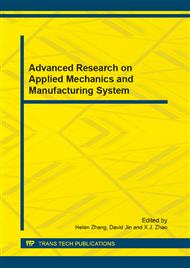[1]
S. Ito,N. Miura,K. Wang, performance of a Heat Pump Using Direct Expansion Solar Collectiors, Solar Energy, vol. 65, no. 3, (1999), p.189~196.
DOI: 10.1016/s0038-092x(98)00124-8
Google Scholar
[2]
S.K. Chaturredi D.T. Chen,A. Kneireddine. Thermal Performance of a Variable Capacity Direct Expansion Solar-Assisted Heat Pump, Energy on version and Management, vol. 39, no. 4, (1998), p.181~191.
DOI: 10.1016/s0196-8904(96)00228-2
Google Scholar
[3]
Chaturvedi S K, Abazeri M, Transient Simulation of a Capacity-Modulated Direct-Expansion Solar-Assisted Heat Pump, Solar Energy, 39, (1987), p.421~428.
DOI: 10.1016/s0038-092x(87)80060-9
Google Scholar
[4]
A. Campoccia, L. Dusonchet, E. Telaretti, G. Zizzo. Comparative analysis of different supporting measures for the production of electrical energy by solar PV and Wind systems: Four representative European cases. Solar Energy. Vol. 83, no. 3, (2009).
DOI: 10.1016/j.solener.2008.08.001
Google Scholar
[5]
Md. K. Nazeeruddin, , Etienne Baranoff, Michael Grätzel. Dye-sensitized solar cells: A brief overview. Solar Energy. Volume 85, Issue 6, (2011), p.1172–1178.
DOI: 10.1016/j.solener.2011.01.018
Google Scholar
[6]
S.K. Pardeshi, , A.B. Patil. A simple route for photocatalytic degradation of phenol in aqueous zinc oxide suspension using solarenergy. Solar Energy, Volume 82, Issue 8, (2008), p.700–705.
DOI: 10.1016/j.solener.2008.02.007
Google Scholar
[7]
Matthew C. Beard, Aaron G. Midgett, Mark C. Hanna, etc. Comparing Multiple Exciton Generation in Quantum Dots To Impact Ionization in Bulk Semiconductors: Implications for Enhancement of Solar Energy Conversion. Nano Letters. vol. 10, (2010).
DOI: 10.1021/nl101490z
Google Scholar
[8]
Daibin Kuanga, Pascal Comtea, Shaik M. Zakeeruddina, etc. Stable dye-sensitized solar cells based on organic chromophores and ionic liquid electrolyte. Solar Energy. Volume 85, Issue 6, (2011), p.1189–1194.
DOI: 10.1016/j.solener.2011.02.025
Google Scholar
[9]
Nelson A. Kelly, , Thomas L. Gibson. Improved photovoltaic energy output for cloudy conditions with a solar tracking system. Solar Energy. Volume 83, Issue 11, (2009), p.2092–2102.
DOI: 10.1016/j.solener.2009.08.009
Google Scholar
[10]
Michael D. Kelzenberg, Shannon W. Boettcher, Jan A. Petykiewicz, etc. Enhanced absorption and carrier collection in Si wire arrays for photovoltaic applications. NATURE MATERIALS. vol. 9, (2010), p.239–244.
DOI: 10.1038/nmat2635
Google Scholar
[11]
Gazoli, J.R. ; Filho, E.R. Comprehensive Approach to Modeling and Simulation of Photovoltaic Arrays. IEEE Transactions on Power Electronics, Vol. 24, no. 5, (2009), pp.1198-1208.
DOI: 10.1109/tpel.2009.2013862
Google Scholar



